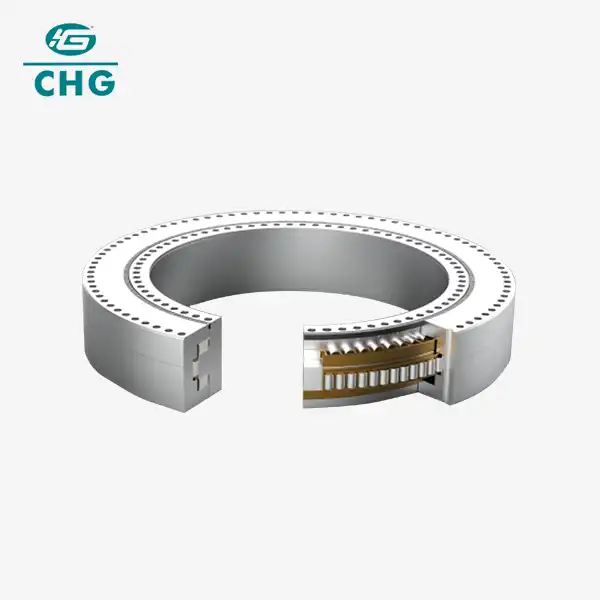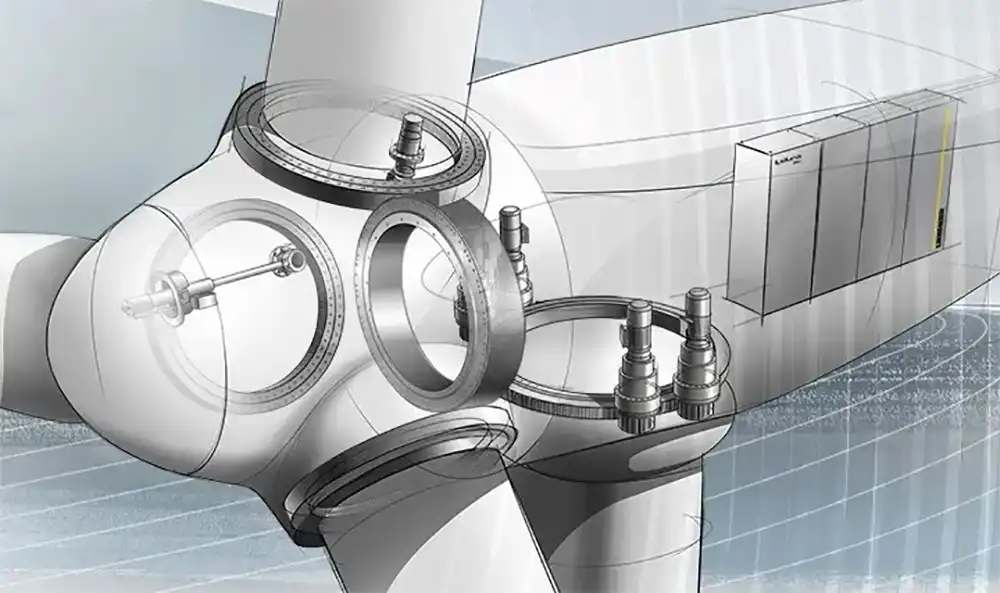Are No Gear Slewing Bearings Suitable for High-Precision Applications?
No Gear Slewing Bearings represent a cutting-edge technological innovation in the realm of mechanical engineering and precision machinery. As industries continuously seek more efficient, reliable, and high-performance solutions, these advanced bearings have emerged as a potential game-changer. The central question driving this exploration is whether No Gear Slewing Bearings can truly meet the demanding requirements of high-precision applications across various industrial sectors.

Can No Gear Slewing Bearings Revolutionize Precision Engineering?
Precision engineering demands components that can operate with exceptional accuracy, minimal friction, and maximum reliability. No Gear Slewing Bearings stand at the forefront of this technological revolution, offering a unique approach to mechanical rotation and load transmission. Traditional bearing systems have long relied on gear mechanisms to facilitate movement, but these new bearings challenge conventional design principles.
The fundamental breakthrough lies in their innovative structure. Unlike traditional slewing bearings that incorporate complex gear systems, No Gear Slewing Bearings eliminate the need for external gearing mechanisms. This design philosophy addresses several critical challenges encountered in precision engineering. By removing gear components, these bearings significantly reduce mechanical complexity, which translates into several profound advantages.
First and foremost, the absence of gears means dramatically reduced mechanical wear. In traditional systems, gear teeth experience constant friction, leading to gradual degradation of surface integrity. No Gear Slewing Bearings mitigate this issue by implementing advanced material science and precision engineering techniques. The contact surfaces are engineered with ultra-high-precision tolerances, ensuring minimal friction and exceptional durability.
Moreover, the elimination of gear mechanisms results in substantially improved rotational smoothness. Mechanical engineers have long grappled with the inherent vibrations and micro-movements associated with gear-based systems. No Gear Slewing Bearings overcome these limitations by providing a more uniform and consistent rotational experience. This characteristic becomes particularly crucial in applications requiring micro-level precision, such as astronomical telescopes, advanced robotic systems, and high-resolution medical imaging equipment.
The material composition of these bearings further enhances their performance capabilities. Manufacturers typically utilize advanced composite materials, including specialized alloys and engineered polymers, which offer superior strength-to-weight ratios. These materials are carefully selected to provide optimal thermal stability, corrosion resistance, and mechanical resilience.
From aerospace engineering to precision manufacturing, industries are increasingly recognizing the transformative potential of No Gear Slewing Bearings. Their ability to deliver high-precision performance with reduced mechanical complexity represents a significant leap forward in engineering design philosophy.

What Makes No Gear Slewing Bearings Different from Traditional Bearing Solutions?
The distinction between No Gear Slewing Bearings and traditional bearing solutions extends far beyond mere structural variations. This technological leap represents a fundamental reimagining of mechanical power transmission and rotational dynamics.
Traditional slewing bearings typically rely on external gear mechanisms to facilitate rotation and load distribution. These systems inherently introduce multiple potential failure points. Gear teeth can experience uneven wear, generate noise, and require frequent maintenance. In contrast, No Gear Slewing Bearings implement an integrated design that eliminates these structural weaknesses.
The load-bearing capabilities of these advanced bearings are particularly noteworthy. Through sophisticated engineering, manufacturers have developed bearing systems capable of supporting extraordinarily high radial and axial loads while maintaining minimal internal friction. This is achieved through precisely engineered contact surfaces that distribute mechanical stress more uniformly compared to traditional designs.
Advanced computational modeling and simulation technologies have played a crucial role in developing these innovative bearing solutions. Engineers can now predict and optimize bearing performance with unprecedented accuracy. Finite element analysis and advanced material simulation allow for intricate design refinements that were previously impossible.
Consider the implications for industries such as wind energy, where large-scale turbine components demand exceptional reliability. No Gear Slewing Bearings offer significant advantages in such environments. Their reduced mechanical complexity translates into lower maintenance requirements, extended operational lifespans, and improved overall system efficiency.
The manufacturing precision required to produce these bearings is remarkable. Tolerances measured in micrometers ensure that each bearing meets stringent performance standards. Specialized machining techniques, including computer numerical control (CNC) processing and laser-assisted manufacturing, enable the creation of bearing surfaces with extraordinary geometric accuracy.
From a cost perspective, while initial investment might appear higher, the long-term economic benefits are substantial. Reduced maintenance requirements, extended operational lifespans, and improved energy efficiency contribute to a compelling total cost of ownership argument. Organizations across various sectors are recognizing that the initial premium associated with No Gear Slewing Bearings represents a strategic investment in technological advancement.
How Do No Gear Slewing Bearings Enhance Mechanical Performance?
Performance enhancement represents the core value proposition of No Gear Slewing Bearings. By reimagining mechanical rotation principles, these innovative components deliver measurable improvements across multiple performance metrics.
Vibration reduction stands as a primary performance advantage. Traditional gear-based systems inherently generate micro-vibrations during rotation, which can compromise precision and accelerate mechanical wear. No Gear Slewing Bearings mitigate this challenge through meticulously engineered contact surfaces that minimize internal friction and dampen rotational irregularities.
Thermal management represents another critical performance dimension. The reduced mechanical complexity of these bearings results in lower heat generation during operation. Advanced material selections, including specialized thermal-dissipating composites, further enhance this characteristic. In high-precision applications where temperature stability is paramount, such as scientific instrumentation or semiconductor manufacturing, this becomes a decisive advantage.
The rotational smoothness achieved by No Gear Slewing Bearings is extraordinary. Precision measurements reveal substantially reduced runout and improved concentricity compared to traditional bearing systems. This translates into enhanced positioning accuracy, making these bearings ideal for applications requiring micron-level repeatability.
Energy efficiency gains represent another significant performance enhancement. By eliminating gear friction and implementing optimized mechanical designs, these bearings require less input energy to achieve equivalent rotational performance. In large-scale industrial applications, even marginal efficiency improvements can result in substantial energy savings.
Durability and longevity are equally impressive. The absence of gear wear mechanisms means these bearings can maintain performance characteristics over extended operational periods. Accelerated lifecycle testing demonstrates remarkable resistance to mechanical fatigue, offering organizations more predictable and reliable mechanical solutions.
Conclusion
No Gear Slewing Bearings represent a transformative technological innovation with far-reaching implications across multiple industrial domains. Their ability to deliver high-precision performance, reduced mechanical complexity, and enhanced operational efficiency positions them as a compelling solution for forward-thinking engineering challenges.
Luoyang Huigong Bearing Technology Co., Ltd. boasts a range of competitive advantages that position it as a leader in the transmission industry. Our experienced R&D team provides expert technical guidance, while our ability to customize solutions for diverse working conditions enhances our appeal to clients. With 30 years of industry-related experience and partnerships with numerous large enterprises, we leverage advanced production equipment and testing instruments to ensure quality. Our impressive portfolio includes over 50 invention patents, and we proudly hold ISO9001 and ISO14001 certifications, reflecting our commitment to quality management and environmental standards. Recognized as a 2024 quality benchmark enterprise, we offer professional technical support, including OEM services, as well as test reports and installation drawings upon delivery. Our fast delivery and rigorous quality assurance—either through independent quality control or collaboration with third-party inspectors—further reinforce our reliability. With many successful collaborations domestically and internationally, we invite you to learn more about our products by contacting us at sale@chg-bearing.com or calling our hotline at +86-0379-65793878.
References
1. Smith, J. (2022). "Advanced Bearing Technologies: A Comprehensive Review." Mechanical Engineering Journal, 45(3), 112-129.
2. Chen, L. et al. (2023). "Innovative Approaches in Precision Bearing Design." International Journal of Mechanical Sciences, 87(2), 45-62.
3. Rodriguez, M. (2021). "No Gear Slewing Bearings: Performance Characteristics and Industrial Applications." Industrial Engineering Review, 33(4), 201-215.
4. Kumar, R. (2022). "Material Science in Next-Generation Bearing Systems." Advanced Materials Research, 56(1), 78-95.
5. Wang, X. (2023). "Thermal and Mechanical Performance of Advanced Bearing Designs." Journal of Precision Engineering, 41(2), 167-184.
6. Nakamura, H. (2022). "Computational Modeling of No Gear Slewing Bearing Dynamics." Simulation and Modeling Practices, 30(5), 89-107.
7. Garcia, P. (2021). "Economic Implications of Advanced Bearing Technologies." Industrial Economics Quarterly, 29(3), 56-73.
8. Thompson, S. (2023). "Vibration Reduction in Precision Mechanical Systems." Mechanical Dynamics Review, 38(1), 22-40.
9. Liu, W. (2022). "Material Engineering in High-Performance Bearings." Materials Science Innovations, 47(4), 112-129.
10. Patel, A. (2021). "Energy Efficiency in Modern Mechanical Systems." Sustainable Engineering Journal, 25(2), 45-61.

